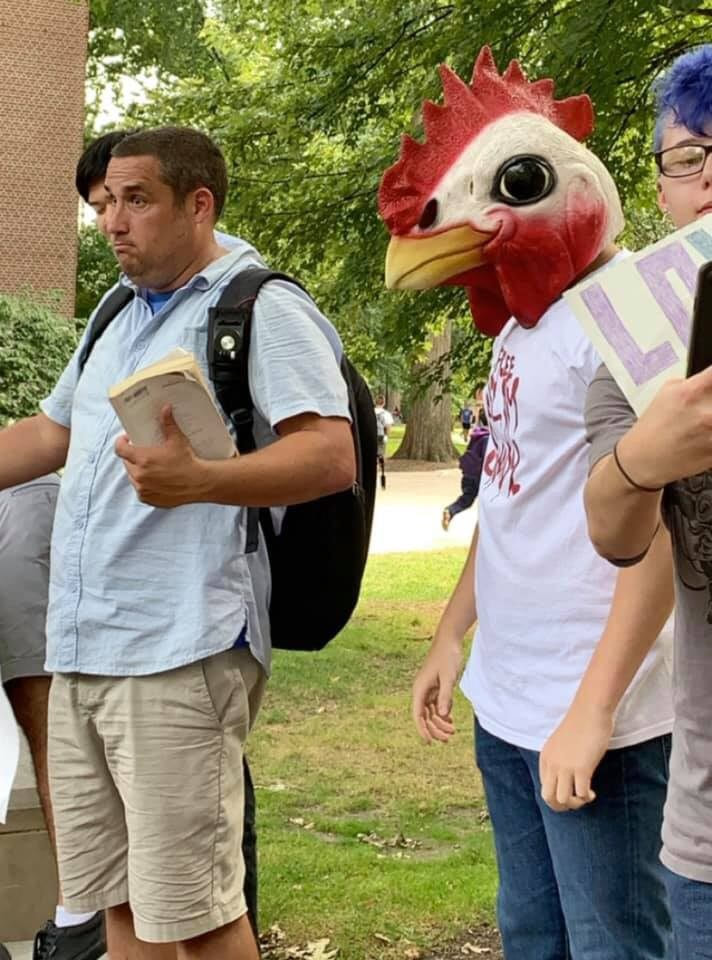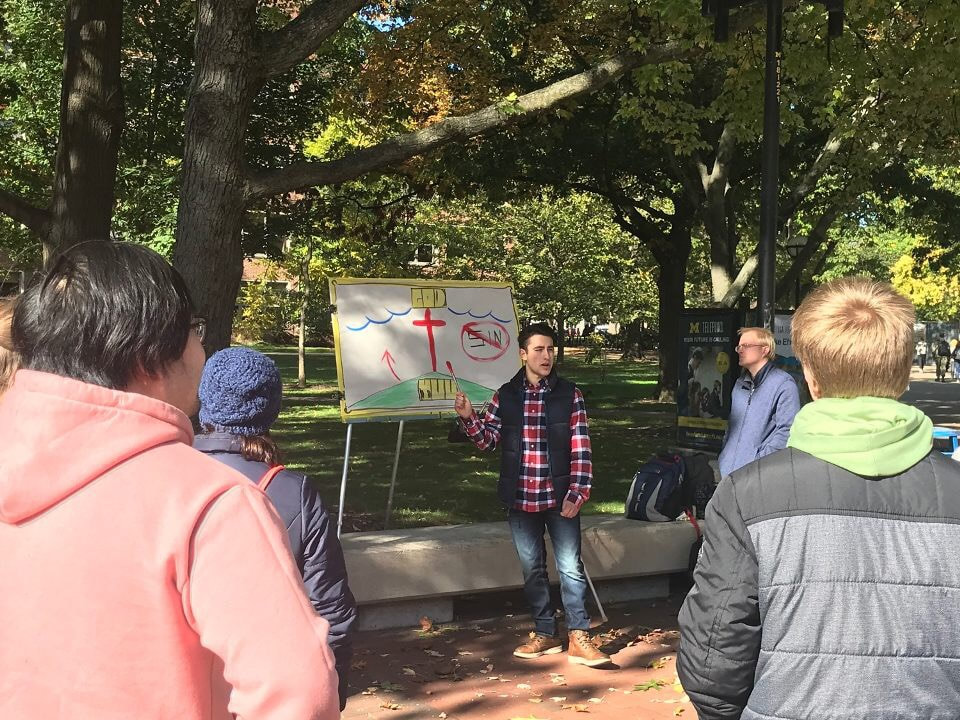|
2/14/2020 1 Comment Preachers and ProtestStephanie Sorter (she/her) The first few weeks of September are unlike any other time of the year. They are a magical, blissful period where students are simply happy to be back on campus before the full brunt of all their classes has started to set in. Days are filled with meeting up with friends, getting lost between buildings, and promising yourself that this will finally be the year you get off that random club’s email list. Campus is filled with hammock enthusiasts and preachers alike as they scramble to make the most out of the diag before the weather goes bad. Some days it feels you can barely go ten feet without tripping over one, whether peacefully cocooned between trees or shouting slurs at the top of their lungs. This last bit, of course, is regarding the infamous diag preachers. While I am sure homophobic hammock users exist, I have yet to meet one.  Ken Fleck and unknown student protesting by means of chicken mask. Photo by Alec Bayoneto. Ken Fleck and unknown student protesting by means of chicken mask. Photo by Alec Bayoneto. These “preachers,” typically wielding signs and flashing their homophobia like it’s a fast pass to heaven, are not a rare sight on Michigan’s campus. Around midday on September 10th a man named Ken Fleck, aka Mr. Ask-Me-Why-You-Deserve-Hell, decided to get a jump on the competition. His sign soon attracted a crowd of onlookers, and before long he had gone from personal attacks against individual students to broad complaints about the state of the world we live in. However, with statements about how he wished to be “brainwashed by God” and how “gay people deserve respect, but also hell,” Ken’s message was one not readily accepted by students passing by. Protest comes in many different forms, and the reactions with which Ken was met represented almost all of them. Students met him with yelling, debating, and even making signs of their own. Freshman Mutaz Faqqouseh stood next to Ken with a sign reading “free stupid lessons” for over six hours after noticing the commotion on his way to class. Although not the person who made the sign, he gladly volunteered to hold it after the original creator had to leave. Faqqouseh did end up missing class but says it was all worth it. Just in case holding his newly acquired sign for so long wasn’t enough, he also tried debating on the nature of Christianity with Ken. When reasonable conversation didn’t seem to work, he resorted to yelling to try to drown out the hate speech. Faqqouseh disagrees with the idea that ignoring incendiary figures can be more effective than actively engaging with them. “If he’s going to be a presence on campus and attack people to draw them into a dialogue,” he said, “then ignoring them is just not going to work.” He also noted that towards the end of the day the whole event became less about what Ken said and more about the sense of community created in direct opposition to him. While this was Mutaz’s first experience with protest in this way, he promised that the next time Ken comes to campus, he’ll be there too. Another student at the protest, Alec Bayoneto, had a similar point of view. Unlike Faqqouseh, however, Bayoneto’s presence was not a coincidence. He had been informed of the situation by his boyfriend, coincidentally also named Alec, and the two met up with the intention of “making a scene.” They staked out a spot right in front and then proceeded to kiss, an action met by the cheering of the crowd and Ken’s growing fury. When asked the same question about ignoring people whose only intention seems to be spreading hate, Bayoneto said that in his opinion, a mob of people protesting acts as a shield, effectively cutting the speaker off from anyone who may agree with him. Besides, he argues, it can be entertaining to ridicule people like Ken. As far as he is concerned, the move was a complete success and something he would do again, with or without a crowd of supporters standing behind him. As the day went on, the man shouting slurs in the middle of campus became less of a spectacle. A traveling street hypnotist eventually stole most of the crowd, and Ken was left alone with only a small handful of students. He had stopped screaming and waving his sign around by then, and he seemed almost willing to engage in civil debate. That being said, in his case “civil” merely means “repeating the same racist and homophobic statements in a slightly more conversational tone.” The lack of a crowd did mean fewer people being affected by his hatred. However, it also meant whoever was unlucky enough to try to understand him was hit with the full force of what he said, present company included. Along with this, the last of the stragglers also got to experience another man coming forward to show his support for Ken. This newcomer then invited all the students in the area to “come to bible study and talk more.” Everyone declined. It is impossible to say whether Ken has been changed at all by this experience. It is also nearly impossible to say the same for the students who opposed him. Was anything achieved through yelling and kissing and sign-holding? Does it matter? Is the sense of community created by occasions like this enough to drive out the pockets of fear and hatred still found in this supposedly progressive age? We cannot know the definite answer to any of these questions. What we can take with us, however, is the knowledge that Ken, and others like him, will keep going to schools around the country and people like us will keep showing up, resisting the spread of hatred.
1 Comment
|
Search by typing & pressing enter

